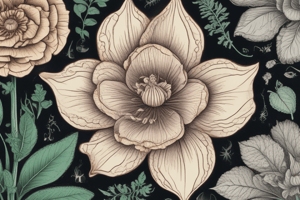Podcast
Questions and Answers
What is the study of internal structure of plants called?
What is the study of internal structure of plants called?
anatomy
Which of the following is NOT a type of tissue system in plants?
Which of the following is NOT a type of tissue system in plants?
- Cytoplasmic tissue system (correct)
- Ground or fundamental tissue system
- Epidermal tissue system
- Vascular or conducting tissue system
The cuticle is present in the roots to prevent water loss.
The cuticle is present in the roots to prevent water loss.
False (B)
Which cells regulate the opening and closing of stomata?
Which cells regulate the opening and closing of stomata?
What is the outermost layer of the primary plant body called?
What is the outermost layer of the primary plant body called?
The outside of the epidermis is often covered with a waxy layer called the ______.
The outside of the epidermis is often covered with a waxy layer called the ______.
What are the unicellular elongations of epidermal cells that help absorb water and minerals called?
What are the unicellular elongations of epidermal cells that help absorb water and minerals called?
Which of the following describes the shape of guard cells in grasses?
Which of the following describes the shape of guard cells in grasses?
Flashcards are hidden until you start studying
Study Notes
Overview of Plant Anatomy
- Study of internal structure of plants is termed anatomy, differentiating between various cells, tissues, and organs.
- Structural similarities and variations exist among living organisms, including plants and animals.
- Higher plants are classified into two main groups within angiosperms: dicotyledonous (dicots) and monocotyledonous (monocots).
Tissue Systems in Plants
- Three primary tissue systems based on structure and location are:
- Epidermal Tissue System
- Ground or Fundamental Tissue System
- Vascular or Conducting Tissue System
Epidermal Tissue System
- Forms the outermost covering of plants, consisting of:
- Epidermal cells
- Stomata for gas exchange and transpiration
- Epidermal appendages such as trichomes and hairs
- Composed of a single layer of compactly arranged parenchymatous cells with limited cytoplasm and large vacuoles.
- The cuticle, a waxy layer on the epidermis, reduces water loss, though it is not present in roots.
- Stomata regulate transpiration and gas exchange, each consisting of:
- Two guard cells that control the stomatal pore opening
- Specialized subsidiary cells surrounding the guard cells
- Guard cells are bean or dumb-bell shaped, possessing chloroplasts to aid in their function.
Root Hairs and Trichomes
- Root hairs are unicellular extensions of epidermal cells that absorb water and minerals from soil.
- Trichomes on stems can be multicellular and vary in structure:
- They can be branched or unbranched
- They may have soft or stiff textures
- Some trichomes are secretory and aid in reducing water loss through transpiration.
Studying That Suits You
Use AI to generate personalized quizzes and flashcards to suit your learning preferences.





